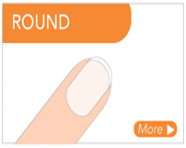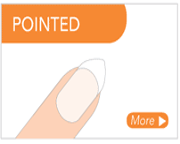There are many terms that are specific to Nail Augmentation. Some are listed below.
|
Terminology |
Definition |
|
Apex |
The high point which is just above the stress area. |
|
Smile line |
The natural nail area where the nail plate leaves the nail bed; free edge; when referring to the extension this is the clean white line in zone one. |
|
Upper arch |
The curve of the nail from the cuticle to free edge. |
|
Lower arch |
The curve of the extension from the sidewall to the edge of the tip. |
|
Free edge |
The portion of the nail that extends beyond the nail bed. |
|
Pink to white ratio |
For balance it is one third white to two thirds pink. Some fashion styles will dictate a different ratio. |
|
Extending the nail bed |
This is usually related to enhancements and completed using a covering product to make the nail look longer or hide any blemishes. It allows the white free edge to be situated higher to make the nail appear longer. |
|
Creating a nail bed |
This is done using enhancements of Acrylic or Gel and is to allow a technician to create a beautiful nail. This method is essential for clients with bitten nails. |
|
Overlays |
Applying enhancements over the natural length of client’s nail. |
|
Gel polish |
Also called a chip-less manicure, gel-polish is applied like traditional polish, but is cured under a UV-lamp or LED lamp. The polish is dry immediately after curing and lasts for at least two weeks. |
|
Tips |
ABS plastic used to create length for enhancements. Apply using glue and use tip cutters to cut to desired length, shape using a file. |
|
Forms |
Paper or metal aids placed at the end of the free edge to lengthen the nails without the use of a tip and then removed once application has taken place. |
|
Breaks |
Refers to broken acrylic or gel enhancements. This can be due to improper application, client wear and tear or not maintaining the enhancements as recommended just to name a few reasons. |
During the consultation it is important to consider the shape that would most suit your client, discuss his/her lifestyle and preference. Nail shapes should usually conform to the shape of the fingers for a more realistic natural appearance.
Square
This shape is usually more suited to manual workers or those who do a lot of work with their fingertips e.g., typists/pianists.

Round
This is a good shape for those who want a short, neat style. It decrease’s the likelihood of breakage, it is suited to those with large square hands.

Oval
This shape can appear to give length to the nail for a more elegant appearance; it is suited to smaller hands.

Pointed
This is not a recommended shape as it is likely to cause breakage.

There are many shapes you can file client’s nails into, from the sensible to the fashion of the time. Celebrities have a huge influence on the trends of the year or season. These are constantly changing, with new nail shapes becoming almost a form of art!

Depending on which country you are in, nail shapes may have a different name, e.g. coffin nails are also known as ballerina nails. The table below lists the most common nail shapes.
|
NAIL SHAPE |
DESCRIPTION |
|
Oval |
Oval nails give the effect of length without producing a fragile point. Often regarded as the most desirable shape. |
|
Square |
Square nails follow the shape of the fingertip. This shape suits people who require their nails to be short, e.g. cooks, health care professionals, therapists. |
|
Squoval |
This is a combination of square and oval. The shape is durable and hard wearing. Suits medium to long nails. |
|
Pointed or Stiletto |
Pointed nails are the weakest nail shape and are not usually recommended. |
|
Round |
Round nails are slightly tapered and extend just a bit beyond the tip of the finger. Best suited to small, thin hands. |
|
Almond |
The nails are filed away at the sides and softly pointed at the tip. This shape is not very strong and if damaged some of the length will have to be filed away to rectify. |